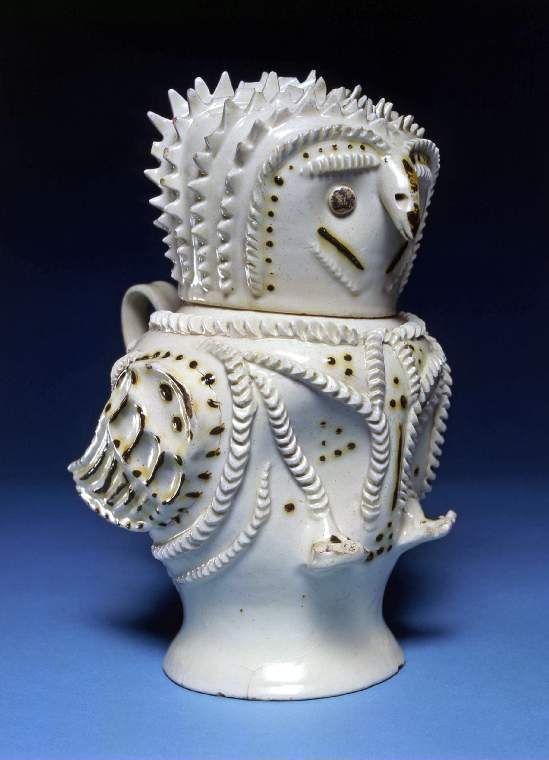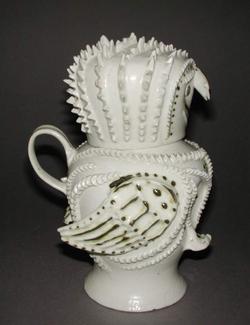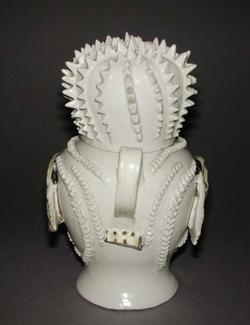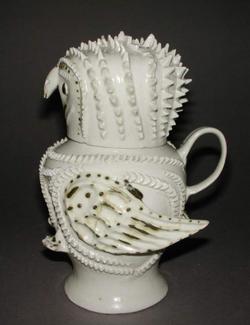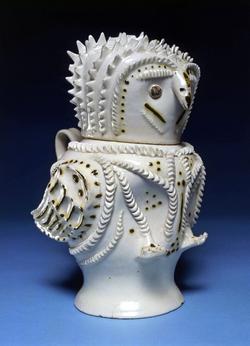Current Location: Gallery 27 (Glaisher)
Maker(s)
Factory:
Unidentified Staffordshire factory
Entities
Categories
Description
White salt-glazed stoneware, the body and head thrown separately, and decorated with applied notched clay feathers, and details in brown slip. A strap handle is attached to the back of the body. The detachable head serves as a cup.
Notes
History note: George Stoner Collection, Cotleigh, West Wickham, Kent; purchased from George Stoner of Stoner & Evans, in London, on 24 November 1915 (with a slipware owl C.252 & A-1928 for £280)
Legal notes
Dr J.W.L. Glaisher Bequest
Measurements and weight
Height: 21.7 cm
Acquisition and important dates
Method of acquisition: Bequeathed
(1928-12-07)
by
Glaisher, J. W. L., Dr
Dating
18th Century, Mid
George II
Circa
1735
CE
-
Circa
1755
CE
Note
Brown salt-glazed stoneware owl jugs were made in Cologne in the mid sixteenth century, but despite the vast quantities of stoneware bottles to be imported from the Rhineland, only one owl jug is known to have been imported and to have survived in an English collection. It has silver mounts round its neck and foot, and was given to the Worshipful Company of Armourers and Braziers in 1537 by the widow of William Vinyard, alias Seger, and still belongs to the Company. Another owl jug, excavated in Cologne on the site of the Maximinenstrasse worshop is in the Kunstgewerbe-museum in Cologne. Although there is no proven link, it is possible that one of these early owl jugs might have inspired the Staffordshire versions.
Tin-glazed and painted earthenware owls were made in Austria and the Tryol, where they, and silver owls, are said to have been made as prizes for archery competitions. They were also made in enamelled glass in Bohemia in the late 16th and early 17th century. An example dated 1582, with a restored cover and foot, was sold by Sotheby’s Olympia, on 18 July 2007, The Summer Sale, European Ceramics, Glass, Silver and Vertu, lot 69. Two more are known. The earliest, dated 1597, also lacking its cover, is in the Museum of Applied Arts in Prague. The other at Waddesdon Manor, Buckinghamshire (National Trust, inv. no. 3137), is dated 1605, and has a German inscription ‘An‘An owl am I/All birds hate me’.
School or Style
Rococo
People, subjects and objects depicted
Components of the work
Decoration
composed of
slip
( dark brown)
Surface
composed of
salt-glaze
Both Parts
Details
Feathers
Materials used in production
white
Stoneware
Techniques used in production
Salt-glazing
References and bibliographic entries
-
The Connoisseur
page(s): 238
-
English Pottery, Its Development from Early Times to the End of the Eighteenth Century
-
Catalogue of the Glaisher Collection of Pottery and Porcelain in the Fitzwilliam Museum Cambridge
page(s): 78
-
Early Staffordshire Pottery
page(s): 26
-
Birds in European Ceramic Art I, The Owl
page(s): 112-17
-
James Whitbread Lee Glaisher, ScD, FRS (1848-1928), A Cambridge Mathematician and Collector
page(s): 181
-
White Salt-glazed Stoneware of the British Isles
page(s): 110
-
The Jean and Kenneth Chorley Collection
page(s): 53
-
Important English Pottery, The Harriet Carlton Goldweitz Collection
page(s): 90-1
-
Gothic Art for England 1400-1547
page(s): 322
-
The James A. de Rothschild Collection at Waddesdon Manor, Glass and Enamels
page(s): 156-7
-
The Summer Sale, European Ceramcs, Glass, Silver, and Vertu
page(s): 48
Identification numbers
Accession number: C.497 & A-1928
Primary reference Number: 75299
Old object number: 3737
Stable URI
Audit data
Created: Saturday 6 August 2011
Updated: Monday 13 January 2025
Last processed: Tuesday 15 July 2025
Associated departments & institutions
Owner or interested party:
The Fitzwilliam Museum
Associated department:
Applied Arts
